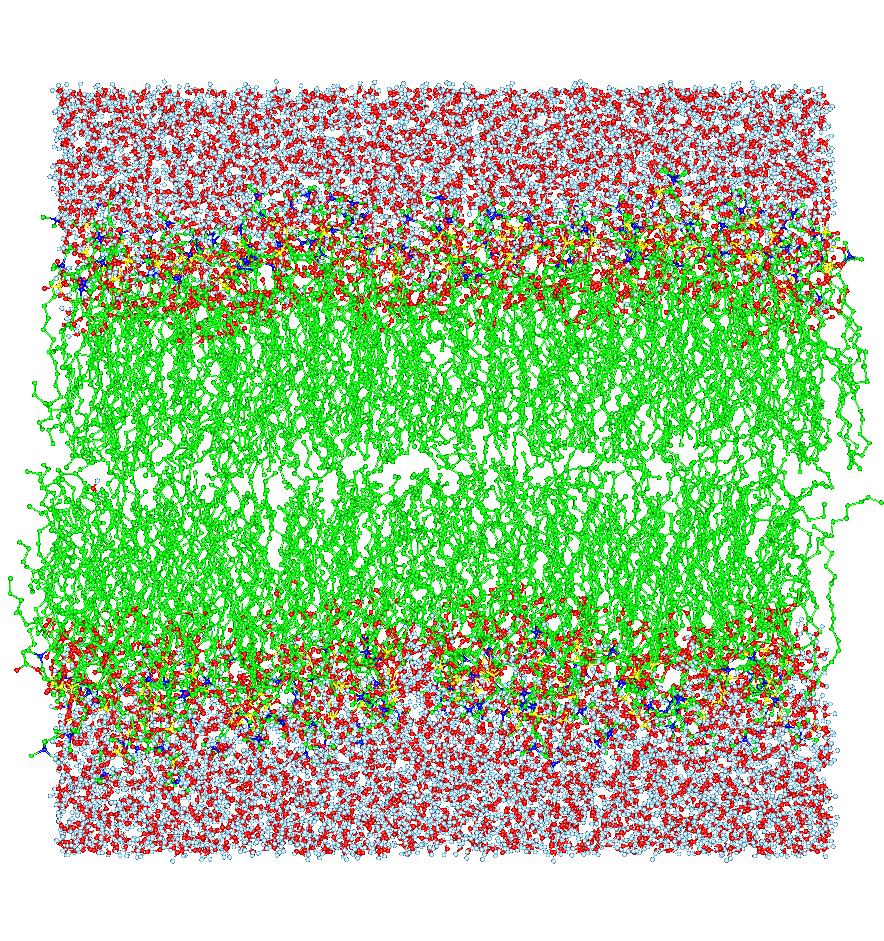
Lipid membranes is the basic constructional unit of living
cells. It is formed by lipid molecules, having a hydrofilic polar
group and one, two or more hydrocarbon tails. Lipids with two tails
bild typically bilayers.
This fragment of lipid bilayer is
composed of 256 DPPC lipids and 6000 water molecules.
C.-J. Högberg and A.P.Lyubartsev "A Molecular Dynamics
Investigation of the Influence of Hydration and Temperature on
Structural and Dynamical Properties of a
Dimyristoylphosphatidylcholine Bilayer" J. Phys. Chem. B,
110(29), 14326-14246 (2006) Abstract
and text
There are two main outcome of this study. First,
is that dehydration of bilayer increases molecular order. This is
seen from increase of the order parameter, lower area per lipid,
slowing down of diffusion and reorientational motion. The second
conclusion was that while structural properties of bilayer are only
moderately affected by the change of hydration, the dynamical
properties are affected more drastically.
How do local anesthetics work?
Experimental studies show that addition of local anesthetics to lipid membranes causes blocking of voltage-gated Na+ channels. As Na+ - K+ ion exchange is responsible for propagation of siglals along the nerves, this is now the generally accepted theory of the anesthetic action. But what is hapenning on the molecular level, why does addition of anesthetics such as lidocaine causes blocking of ion channels? There are mainly two points of view. First is that anesthetics bind directly to the ion channel and stop its proper work. Another is that anesthetics affect properties of lipid membrane which in turn causes blocking of ion channels. We have carried out molecular dynamics simulations in order to get insight into this question.
The most interesting finding is that addition of lidocaine increases electrostatic potential inside membrane. The increase in quite substantial, being of the order of 100 mV at 10 mol% lidocaine concentration in membrane. The increase is also almost independent on whether protonated or neutral form of lidocaine is added. Such an increase of the elecrostatic potential is above the typical values of transmembrane potential (70mV) and thus may be a plausible reason of why do lidocaine block ion channels. The specific structural features of lidocaine molecule and their orientation in the bilayer, leading to the observed increase of the electrostatic potential, turned out to be common for other local anesthetics. See details in papers:
C.-J. Högberg, A. Maliniak and A.P.Lyubartsev "Dynamical and structural properties of charged and uncharged lidocaine in a lipid bilayer" Biophys. Chem., 125, 416-424 (2007) Abstract and text
C.-J.Högberg and A.P.Lyubartsev, "Effect of local amesthetic lidocaine on electrostatic properties of a lipid bilayer", Biophys. J., 94, 525 (2008). Color figure version published on-line at Biofast http://www.biophysj.org/cgi/content/abstract/biophysj.107.104208v1 doi:10.1529/biophysj.107.104208
Similar results, that is increase of the electrostatic potential inside membrane, were demonstrated for another local anesthetic articaine:
E. H. Mojumdar and A. P. Lyubartsev "Molecular Dynamics Simulations of Local Anesthetic Articaine in a Lipid Bilayer" Biophys. Chem., 2010, 153, 27-35. DOI:10.1016/j.bpc.2010.10.001 Abstract and text ; Open Access fulltext
As a first attempt to improve all-atom CHARMM 27 force field for simulation of lipid bilayers, a modification of CHARMM27 for DMPC lipids has been done which improve agreement with experiment for a number of important parameters of lipid bilayers. The most important achievement was a model which perfectly reproduces area per lipid simulated at zero tension conditions. Other properties, such as order paarmeters and structure factor, showed also good agreement with experimental values. See details in:
Recently we initiated further development of an all-atomistic force field (FF) for phospholipids in a more regular manner with emphasis on high-level ab initio calculations keeping the empirical input to a minimum. We demonstrated ability of the new FF to simulate lipid bilayers in the liquid crystalline phase in a tensionless ensemble in simulations of both saturated and unsaturated phosphatydylcholine lipids with PC, PE, PS and PG headgroups for a range of temperatures, reproducing available data on x-ray and neutron scattering factors, order parameters and area per lipid. Liquid-crystalline to gel phase transition is also reproduced. Furthermore, the compatibility with the AMBER FF for biomolecules was demonstrated. The papers describing this work are:
Joakim P. M. Jämbeck and Alexander P. Lyubartsev : "Derivation and Systematic Validation of a Refined All-Atom Force Field for Phosphatidylcholine Lipids" J. Phys. Chem. B, 2012, 116 (10), pp 3164 - 3179 Open Access Full Text
Details of the developed force field, including topology and force field (.itp) files files for GROMACS and equilibrated configurations, are given at this Web Page:"Computer Simulations of Heterogeneous Biomembranes".
Atomistic simulations of lipids and lipid bilayers requires
enormous computer resourses. However, for description of larger-scale
properties all-atomic details may be not necessary, and such
properties may be described on a coarse-grained level. The problem in
this case is how to formulate a coarse-grained model. See more
information at this page:
Coarse
grained models for lipids
Alexander Lyubartsev